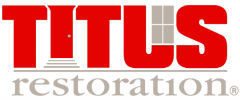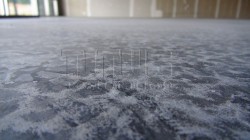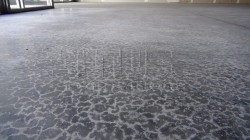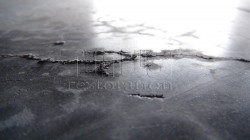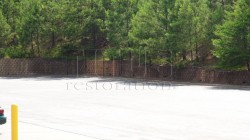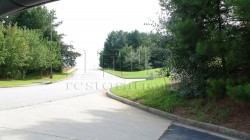A slick and slippery concrete floor is not normal! A wet floor may cause accidental slips, trips, and falls and can be very dangerous for forklift and other machinery as they may be unable to brake or stop when needed. Most often, the cause of a damp concrete floor can be explained as Sweating Slab Syndrome. Most times Sweating Slab Syndrome is accompanied by concrete efflorescence. Efflorescence appears as a white, powdery substance often in a map cracking pattern and is the result of the evaporation of the accumulated moisture.
- Moisture on Concrete
- Sweating Slab
What are the causes of efflorescence and Sweating Slab Syndrome (that can make warehouse and factory floors slippery and dangerous) and more importantly, what can we do to prevent your concrete floor from being slippery?
In this page we will discuss the following:
- The Causes of Sweating Slab Syndrome
- What is Concrete Efflorescence
- Concrete Efflorescence Conditions and Chemical Factors
- Remedy to the Sweating Slab Syndrome
- Customer Choice of Finishes
The Causes of the Sweating Slab Syndrome
What causes sweating slab syndrome? There are many symptoms of sweating slab syndrome:
- There is a moisture build-up on the concrete floor. Seems like a wet floor.
- The concrete slab is darkened and slick.
- There is efflorescence on the concrete floor surface.
Sweating Slab Syndrome is caused by one or a combination of the following factors:
- Alkali content
- Hydrostatic pressure
Salt deposits on the surface of the slab can lead to SSS. Salt acts as a humectant, which attracts and retains moisture from the air and possibly from within the concrete. Liquid surface densifiers are popular treatments that enhance the appearance and performance of a concrete slab surface. However, these treatments are typically sodium or potassium silicate-based (salt) treatments. High pH levels at the surface of concrete can attract moisture as Mother Nature acts to equalize an existing pH imbalance by drawing moisture from the concrete slab towards the surface or from the air above the slab. This not only causes dis-bonding and saponification of paints or floor sealers but the salts themselves attract atmospheric moisture.
Buildings that are situated on a lot that has been terraced by the developer create a water tower effect with hydrostatic pressure. Since hydrostatic pressure is approximately 1/2 lb of pressure per square foot of elevation drop, a 20 foot drop in elevation causes about 10 lbs of water pressure beneath the lower-elevation building. Retaining walls or sloped hills are an indication that this is present. In addition, if there is more moisture build-up after a heavy rain or high humidity day, hydrostatic pressure forces the ground moisture beneath the concrete floor to wick up through the concrete and enter the building atmosphere.
What is Concrete Efflorescence
Efflorescence is a crystalline deposit of water-soluble salts left on the surface of masonry and concrete as the water evaporates. Efflorescence is a partner of Sweating Slab Syndrome. This article is intended to address only efflorescence in concrete floors and more specifically, secondary efflorescence.
- Crystalline Salt on the Slab
Click on following pictures to enlarge them and to have a better understanding of map cracking.
-
Primary Efflorescence
Primary efflorescence occurs during the initial cure of a cementitious product. It occurs in new masonry more often than new concrete due to the numerous open travel paths of moisture and salts to the masonry surface. In concrete, water moving through the capillaries of the concrete are being driven out as a result of the heat during the hydration of cement. The water brings salts to the surface that are not bound to the concrete. As the water evaporates, it leaves the salt behind, which forms a white, fluffy deposit, that can normally be brushed off. The resulting white deposits are referred to as “efflorescence”.
-
Secondary Efflorescence
Secondary efflorescence does not occur as a result of the concrete curing process, rather, it occurs after the concrete has cured – sometimes months or years later. It is usually due to an external source of water forcing soluble sulfates to the surface of the concrete through passage ways in the concrete (cracks and capillaries).
-
The Traveling Path of Soluble Sulfates
For efflorescence to appear, the soluble alkali sulfates must be able to travel through the pores and cracks in the concrete slab to the surface of the concrete slab. If the pores and cracks in the concrete slab can be reduced in size, it becomes harder for the salts to migrate through to the surface. It is our experience that very tightly steel troweled slabs will have more evidence of moisture and less evidence of efflorescence, while slabs that are softer on the surface will have more visible efflorescence. Consolidating the concrete slab with mechanical vibration and multiple passes with the steel troweling machine will greatly reduce any voids in the concrete for soluble salts to pass through. Slabs that are highly power troweled are referred to a “burned”. They have a very dense hard cap, often scratching a 7 or greater on the MOHS hardness scale. These slabs are also black in color, thus the industry terminology of a “burned” steel troweled finish.
-
The Source of Efflorescent Salts
An analysis of efflorescent salts reveals that they are mainly made up of water soluble alkali salts of sodium sulfate, potassium sulfate, and magnesium sulfate (solutions containing magnesium are typically more aggressive). Efflorescence is predominately white in color, but it can also be brown, green, or yellow – depending on which salts are present.
Concrete Efflorescence Conditions
There are three (3) things that must be present to cause efflorescence:
- There must be enough moisture in the concrete slab to make the salts soluble.
- There must be sufficient water soluble salts present somewhere in the concrete.
- There must be a path for the soluble salts to migrate through to the surface where the moisture can evaporate. When the moisture evaporates on the surface of the concrete they are left on the concrete slab to crystallize and cause efflorescence.
All three conditions must exist to cause efflorescence. If any one of these conditions is not present, then efflorescence cannot occur. Even though the efflorescence problem is complex, it may not be difficult to prevent.
The Source of Sulfates
Sulfates can come from external or internal sources. An example of an external source of sulfate entering in to a concrete slab is ground water. Ground water from below the concrete can be the source that make the salts soluble.
External Sulfates That Cause Soluble Sulfates
Groundwater and Hydrostatic Pressure…
Hydrostatic pressure increased the force, or PSI, of the groundwater that is forcing its way into the concrete slab. It is very common for slabs with hydrostatic pressure issues to have efflorescence and Sweating Slab Syndrome.
Here are issues to consider when hydrostatic pressure may be affecting your slab:
(Hydrostatic pressure is calculated at ½ lb. of pressure for every 1 foot of elevation. )
- Below grade concrete slab (basements).
- Building slab built without a vapor barrier (directly on soil containing sulfates and moisture).
- Building slab built over gravel but surrounded by poor draining soil. The gravel acts as a French drain to attract the water, but the water is held beneath the slab by the poorer draining soil at the perimeters.
- Buildings built below hills or on lower levels of terraced land in a development. (See pictures below)
- Hydrostatic Pressure
- Hills
Note: In one instance, Titus visited a Sweating Slab Syndrome site that was adjacent to a one (1) acre lake. The lake was 30’ higher than the base of the building’s concrete slab. Another potential source of highly soluble salts in concrete slabs is soil or clay. Salts from clay are found in both the soil and building products such as brick.
Internal Sulfates That Cause Soluble Sulfates
Sulfates can also exist internally in the concrete itself. These internal soluble sulfates are introduced into the concrete at the time of mixing. Gypsum in the aggregate is an example of this type of soluble sulfate.
The Titus S3 TM Process For Treating Sweating Slab Syndrome and Efflorescence
Sweating slab syndrome (SSS) and efflorescence can be treated. Titus Restoration offers a cure for Sweating Slab Syndrome and efflorescence in warehouse, factory, and manufacturing plants. Titus’ process works to chemically eliminate the effects of 3 the necessary elements for Sweating Slab Syndrome and efflorescence: Salts are neutralized, moisture is impeded deep within the concrete slab so that remaining salts cannot become soluble and travel to the surface, the capillaries of the concrete are restricted deep within the slab to substantially interfere with, if not eliminate, any pathway for the salts to reach the surface. Titus’ proprietary process for treating SSS and efflorescence is seven-fold:
- We survey the site
- We perform moisture and hardness testing
- We prepare the concrete slab in a proven method to obtain maximum depth of chemical penetration
- We chemically treat the concrete to neutralize the soluble sulfates that cause efflorescence
- We inhibit the travel path to the surface of the concrete by the application of a deep penetrating chemical process
- We apply a topical chemical treatment that further closes the capillaries of the concrete at the near surface level
- We finish the treated concrete slab in accordance with the customer’s direction.
Customer Choices of Finishes
The customer may choose between:
- A very high traction concrete floor profile (flat finish and slightly textured to the touch)
- A more easily cleaned surface of Titus Hybrid TM Polished Concrete (certified as high traction by the National Floor Safety Institute (NFSI)
- The Titus HP2 TM High Polish / High Performance concrete (NFSI certified as high traction to 3000 grit)
Finally, if this is all too much information, we recommend evaluating the footwear for employees as the easiest way to prevent slips, trips, and falls. See our blog on slip resistant shoes for these circumstances.
Read more on this topic:
www.titusrestoration.com/blog/problems/wet-concrete-floors/
www.titusrestoration.com/blog/safety/oil-slip-resistant-shoes/
